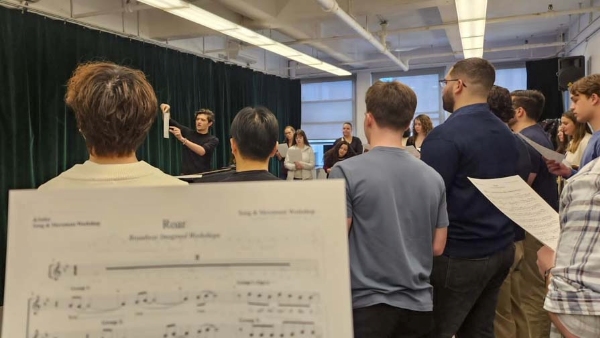Along with well-known painters like Willem de Kooning and Helen Frankenthaler, Christie’s Publish-Struggle to Current sale shines a light-weight on under-recognized summary artists from the Twentieth century
In his essay Modernist Artwork, from 1961, the critic Clement Greenberg argues that portray needs to be a ‘pure’ exercise, that its which means ought to come from throughout the confines of the canvas, rejecting emotional expression, illusionism, and ‘any house that recognizable objects can inhabit.’ Modernist, or summary, portray within the Twentieth century needed to disentangle itself, he mentioned, from different mediums and strategies, stripping itself again to its barest essence: paint on a canvas, materiality and texture.
On 29 September, Christie’s Publish-Struggle to Current sale will function the emblematic artists of Twentieth century abstraction — from painters like Willem de Kooning and Helen Frankenthaler who, as a part of the seminal era that solid a world throughout the confines of a canvas, have been extensively exhibited around the globe, to others like Stanley Whitney, Frank Bowling and Lynda Benglis, whose pivotal contributions to the style have not too long ago come again into the highlight and are actually receiving wider recognition.

Willem de Kooning (1904-1997), Untitled (Montauk Sequence), 1969. Oil and masking tape on paper laid down on canvas. 30 ¾ x 22 ⅜ in (78.1 x 56.8 cm). Estimate: $150,000-200,000. Supplied in Publish-Struggle to Current on 29 September at Christie’s New York
Whitney, born in Philadelphia in 1946, moved to New York in 1968 and started honing his summary visible language. His tendency towards true abstraction and his early experiments in color blocking would make his work distinct from different extra political and theoretical artists within the metropolis, who had been involved extra with confronting themes of racial and cultural identification.
The model he employs in Midnight Hour owes to this appreciation of Shade Subject painters and Minimalism, however was actually developed within the Nineties following time spent in Italy and Egypt. As he mentioned in an interview with Grégoire Lubineau in 2018, ‘After I went to Egypt I noticed I may put all the color collectively and never lose the air: I noticed the house was within the color. That is once I began making my mature work. 1993, 1994. I went there, and I used to be like “Bought it!” Density was the final piece of the puzzle.’
This density was not simply filling up house. It was about appreciating the load, the airiness of a color by itself, and seeing how that modified the airflow all through the piece. ‘How may one create house within the color on a grid?’ questioned Whitney, when requested concerning the origin of this model. ‘How may I lay two colors so shut to one another and never entice them, however somewhat enable air for the canvas to breathe?’

Stanley Whitney (1946), Untitled, 2016. Oil on canvas. 60 ⅛ x 60 ⅛ in (152.7 x 152.7 cm). Estimate: $400,000-600,000. Supplied in Publish-Struggle to Current on 29 September at Christie’s New York
He would share with different artists this appreciation for alternate perceptions of color. Whitney in his ‘mature work’, as he calls them, grew to become most involved with this interplay between density and airflow — ‘house in color, as an alternative of color in house.’ Different artists, like Josef Albers when he emigrated from Germany to america, used geometric, grid-like compositions otherwise. Slightly than learning their mass, he explored how they straight interacted on the canvas.
A pupil and finally a instructor on the Bauhaus, Albers was compelled to depart Germany after strain from the Nazi occasion necessitated the closure of the varsity in 1933. He discovered a instructing place in america, at Black Mountain School in North Carolina, which allowed him the liberty to proceed his work and to carry his creative philosophy to a brand new group of scholars.
When he began instructing at Yale in 1950, he had begun engaged on the collection of work that may eat the subsequent 26 years of his life: Homage to the Sq.. Over lots of of iterations during which the artist nested three or 4 squares, he explored color and its potentialities for conveying subjective expertise inside a good geometric constraint. The three works supplied on this sale — Budding, Spring out, and Residence-Coming — had been made between 1958 and 1962, properly into his research of the shape.
He mentioned of the collection in 1965: ‘All of them are of various palettes, and, due to this fact, so to talk, of various climates. Alternative of the colors used, in addition to their order, is geared toward an interplay — influencing and altering one another forth and again.’
In his geometric abstraction, Albers discovered the liberty to discover the emotional lives of colors via a collection of restraints. By dividing his canvas right into a collection of squares, he may finest perceive and expose their relationships to one another. Later artists would strategy this otherwise, taking type and texture as a requisite avenue of exploration in tandem with color.
Working primarily in sculpture, Lynda Benglis used beeswax earlier than transferring to latex, polyurethane, gold leaf and aluminium within the Nineteen Seventies. Her dramatic entrance into the New York scene was marked by the bodily nature of her medium, and the way she used it to confront concepts of illustration within the artwork world.

Lynda Benglis (b. 1941), Untitled, 1969-70. Pigmented polyurethane foam. 2 ¼ x 46 x 29 in (5.7 x 116.8 x 73.7 cm). Estimate: $80,000-120,000. Supplied in Publish-Struggle to Current on 29 September at Christie’s New York
Her works utilizing phosphorescent paint, hen wire and Pollock-esque paint results had been extremely suggestive and open, in stark distinction to the male-dominated Minimalism of the period. For instance, Untitled from 1970, a multi-coloured polyurethane foam pour that’s without delay candy-coloured and excremental. Its composition straight displays Benglis’ act of making: lugging round half-gallon buckets of latex, she would sacrifice a way of management, letting the medium act of its personal volition somewhat than attempting to tame it.
Benglis’ work was uncared for for a very long time, with many discovering it too charged or dismissing it for its sensual overtones. Since 2009, nevertheless, a renaissance of her work has been in course of, with museums around the globe — most not too long ago the Nasher Sculpture Heart in Dallas, Texas, in 2022 — in search of out her work for retrospective exhibitions.
Participating straight with the confines of the canvas itself, the American painter Sam Gilliam started engaged on a collection of ‘drapes’ within the Nineteen Seventies. These stretcher-less painted canvasses had been suspended from the partitions or ceilings of galleries, giving a extra tactile presence to the often two-dimensional medium.

Sam Gilliam (1933-2022), Idylls I, 1970. Acrylic, metallic paint, crayon and artificial cable on unstretched canvas. Set up dimensions variable: 76 x 61 in (193 x 154.9 cm). Estimate: $600,000-800,000. Supplied in Publish-Struggle to Current on 29 September at Christie’s New York
Made by an African-American artist figuring out of the nation’s capital on the peak of the Civil Rights Motion, Gilliam’s experimentations had been greater than an aesthetic proposition or critique: his ‘drapes’ had been a method of redefining the position of artwork in a society present process dramatic change.
Gilliam was impressed by jazz musicians like John Coltrane. He informed The Artwork Newspaper in 2018, ‘the composition is at all times current however one should let issues go, be open to improvisation, spontaneity, what’s taking place in an area whereas one works.’ Idylls I, an early drape portray from 1970, reveals his curiosity within the Shade Subject painters in addition to the Lyrical Abstraction of the late Sixties.
Concurrently Gilliam was persevering with to develop his observe, the Guyanese-British painter Frank Bowling was gaining acclaim in New York. He had arrived within the metropolis within the late ‘60s after finishing his training on the Royal School of Artwork in London, the place he obtained the silver medal at commencement — gold went to his classmate, David Hockney.
In his solo present on the Whitney in 1971, in addition to his 1972 look on the Whitney Biennial, critics commented on the variations between him and different British painters within the States, who had been predominantly making pop artwork. In distinction, Bowling wielded the twin strategy of Bacon-esque figurative portray — which he deeply admired — and abstraction, punctuated by private emotion. In New York, he got here into contact with Clement Greenberg, who grew to become a detailed good friend and inspired him to additional his research of summary artwork.

Frank Bowling (b. 1934), Barnica Flats VII, 1979. Acrylic and canvas collage on canvas. 26 ⅝ x 70 ⅝ in (67.6 x 177.8 cm). Estimate: $200,000-300,000. Supplied in Publish-Struggle to Current on 29 September at Christie’s New York
Barnica Flats VII, named for the Guyanese coastal city the place he was born, is one among Bowling’s later poured work. In contrast to a few of the poured work which he started making round 1973, this one was not made by simply pouring layers of pre-mixed, contrasting paint. As a substitute he’s working extra on the floor, utilizing paints of comparable tints and making use of them with quite a lot of methods like pouring, dripping and spattering. In keeping with Greenberg’s principle of abstraction, Bowling emphasizes the visible facets of the art work over its narrative content material, however he additionally demonstrates absolute management over the obvious randomness to which his course of lends itself—a course of which he had been learning all through the Nineteen Seventies. This portray reveals his refined course of via a capability to stability deliberate compositional approaches with unintentional gestures brought on by motion of the paint.
Bowling was straight impressed by Greenberg, however the historic development of abstraction via the Twentieth century would solely often align with this principle of artwork. Extra typically, artists actually in search of to find out about their very own course of went additional than merely exploring the inside and exterior of the canvas. Essentially the most radical approaches got here from artists who blurred and even dissolved the borders between mediums, like Lynda Benglis and Sam Gilliam.
Join in the present day
Christie’s On-line Journal delivers our greatest options, movies, and public sale information to your inbox each week
Subscribe
After we consider abstraction, typically our focus brings us to the established names of the style. Artists like de Kooning, Jackson Pollock and Mark Rothko, consultants in color and type, impressed generations of artists after them. They served as inspirations to their friends, those that partook within the Ninth Road Exhibitions, and who had been key members of the Greenwich Village scene within the mid-Twentieth century. Inseparable from the historical past of American-based artwork, and seminal within the improvement of modernist abstraction, different artists — like Bowling, Gilliam and Benglis — nonetheless have their very own tales to inform.


